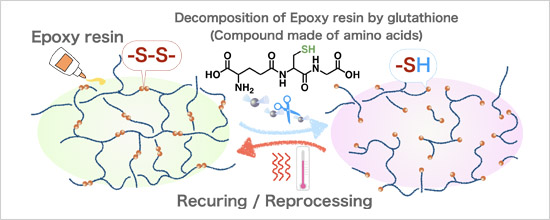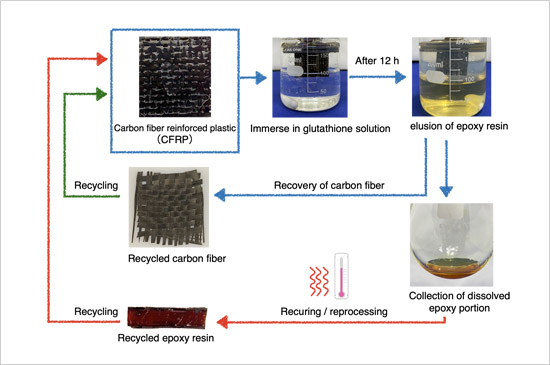Simple Thermoset Plastic Recycling Using a Peptide Solution
—New Strategy for Promoting the Reuse of Carbon Fiber Reinforced Plastics (CFRP)—
2021.07.29
National Institute for Materials Science (NIMS)
Innovative Structural Materials Association (ISMA)
Epoxy resin is a type of thermoset resin commonly used in glue, paint and composite materials. NIMS and ISMA have developed a new thermoset plastic recycling system capable of easily decomposing epoxy resins in an aqueous solution of a naturally derived peptide.
(”Environmentally friendly recycling system for epoxy resin with dynamic covalent bonding” Hsing-Ying Tsai, Takehiro Fujita, Siqian Wang & Masanobu Naito; Journal: Science and Technology of Advanced Materials [July 16, 2021 (JST)]; DOI : 10.1080/14686996.2021.1897480)
Abstract
- Epoxy resin is a type of thermoset resin commonly used in glue, paint and composite materials. NIMS and ISMA have developed a new thermoset plastic recycling system capable of easily decomposing epoxy resins in an aqueous solution of a naturally derived peptide. The use of this system may promote the reuse and recycling of plastics, including carbon fiber reinforced plastics (CFRP)—carbon fibers combined with an epoxy resin matrix—by a wide range of industries.
- Environmental pollution caused by plastics—particularly in the marine environment—has raised global concern about urgent need to promote plastic waste recycling. Some recycling methods have already been developed to decompose thermoplastic resins used in containers and packaging through thermal and chemical processes, and efforts are underway to put recycling plants into practical use. On the other hand, a method for recycling thermoset resins, including epoxy resins, has yet to be developed due to their poor thermal degradability and low solubility in available solvents.
- This research team recently developed an epoxy resin recycling method capable of easily decomposing epoxy resins in an aqueous solution of glutathione—a naturally derived peptide. Glutathione has the ability to remove toxic substances from the human body. Inspired by this detoxification reaction, the team modified the structure of epoxy resin by incorporating disulfide groups (-S-S-) into it, making the resin molecules cleavable by the thiol group (-SH) of glutathione). In this system, epoxy resins immersed in an aqueous solution of glutathione were confirmed to dissolve completely without leaving any solid remains. Decomposed epoxy residue is then recovered and transformed into epoxy resins again. The storage modulus (a stiffness indicator) of the recycled resins was virtually the same as that of the original resins and their performance was only slightly affected by repeated recycling. Because glutathione rarely occurs outside living organisms, there is no risk of it accidentally decomposing epoxy resins still in use under normal conditions.
- There are no other established recycling techniques capable of separating largely incombustible CFRP into carbon fibers and resins and retrieving these materials. The use of this recycling system may promote CFRP recycling. Moreover, this system is applicable to the recycling of other types of resins and composites in addition to epoxy resins. In future studies, the team plans to apply this system to the recycling of a wide range of commonly used plastic materials, thereby fostering the development of a circular plastic economy.
- This project was carried out by a research team consisting of Masanobu Naito (Leader of the Data-driven Polymer Design Group (DPDG), Research and Services Division of Materials Data and Integrated System (MaDIS), NIMS), Hsing-Ying Tsai (Junior Researcher, DPDG, MaDIS, NIMS), Takehiro Fujita (Engineer, DPDG, MaDIS, NIMS) and Siqian Wang (Postdoctoral Researcher, DPDG, MaDIS, NIMS).
This work was conducted in conjunction with another project entitled “Research and development of innovative structural materials” (project code: JPNP14014) funded by the New Energy and Industrial Technology Development Organization (NEDO). - This research was published in Science and Technology of Advanced Materials on July 16, 2021, Japan Time.

Figure 1: Recycling system of epoxy resin with peptide solution

Figure 2: Proposed recycling system of CFRP
Related files
- Research and Services Division of Materials Data and Integrated System (MaDIS)
Contact information
(Regarding this research)
-
Masanobu Naito
Group Leader
Data-driven Polymer Design Group
Research and Services Division of Materials Data and Integrated System
National Institute for Materials Science
Tel: +81-29-860-4783
E-Mail: NAITO.Masanobu=nims.go.jp
(Please change "=" to "@")
(General information)
-
Public Relations Office
National Institute for Materials Science
Tel: +81-29-859-2026
Fax: +81-29-859-2017
E-Mail: pressrelease=ml.nims.go.jp
(Please change "=" to "@")
(Regarding the NEDO project “Research and development of innovative structural materials”)
-
Public Relations Office (attn.: Hyodo)
Technical Planning Division
Innovative Structural Materials Association (ISMA)
Tel: +81-3-6213-5655
E-Mail: pr=isma.jp
(Please change "=" to "@")
